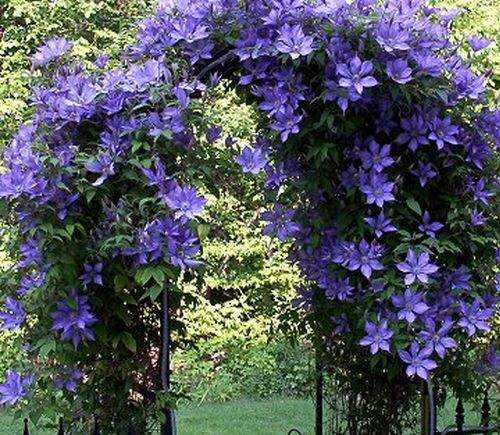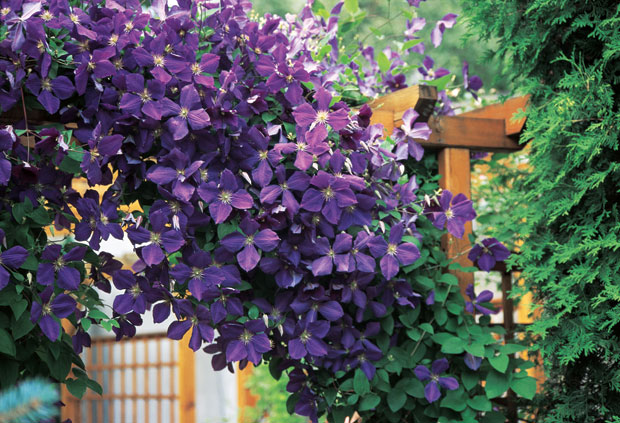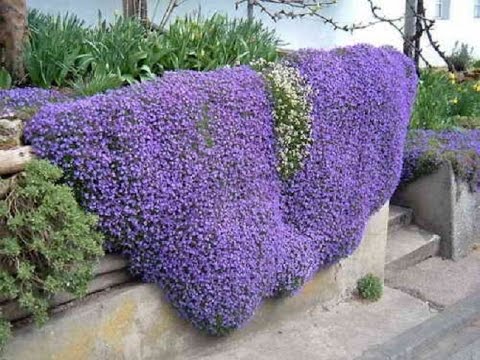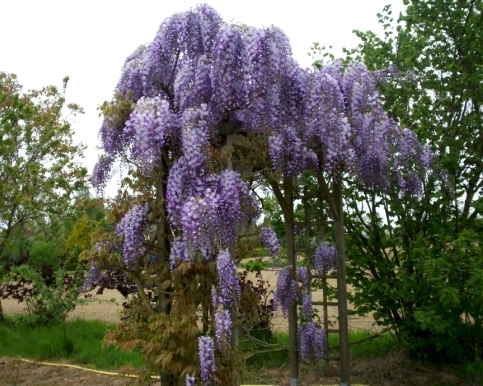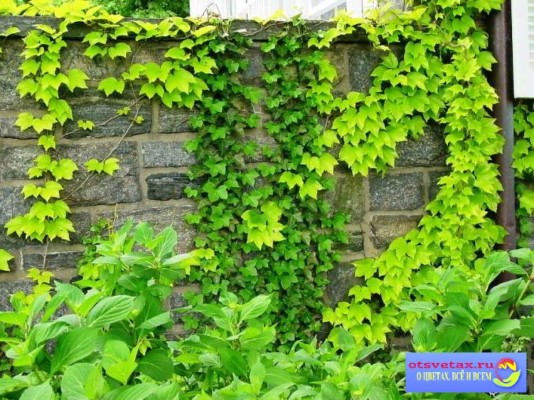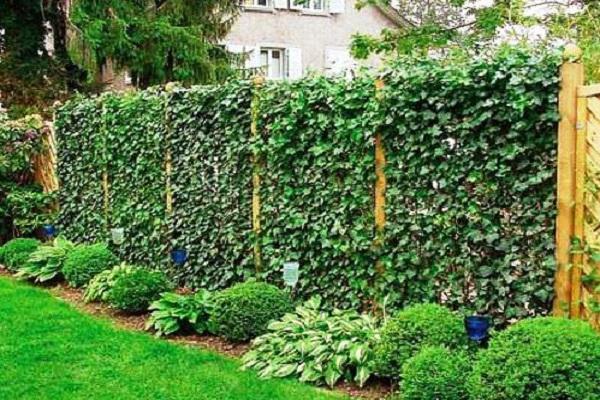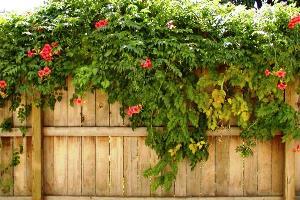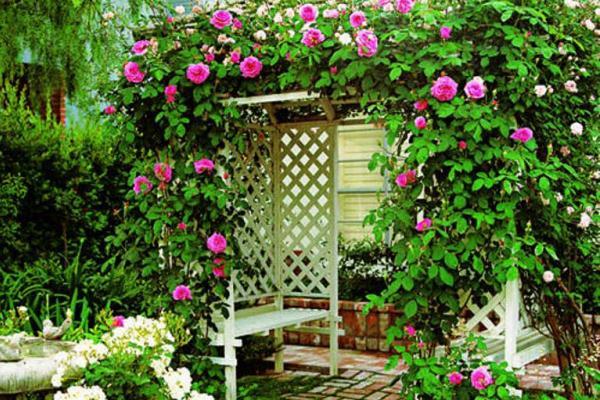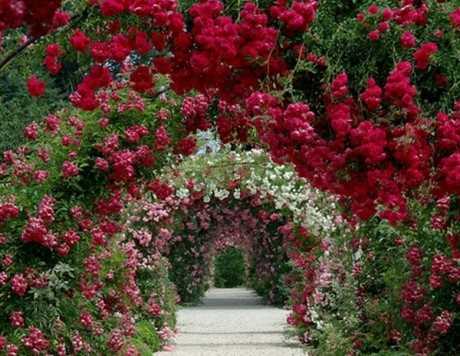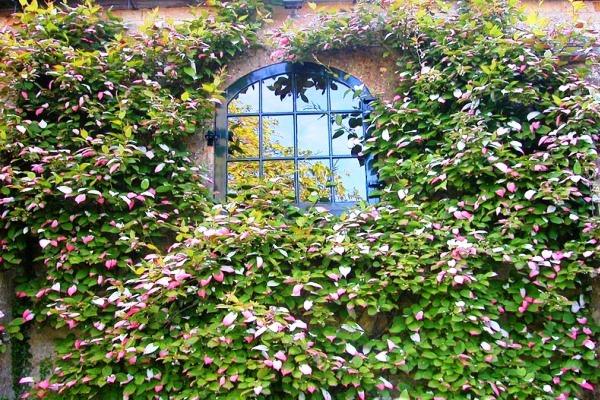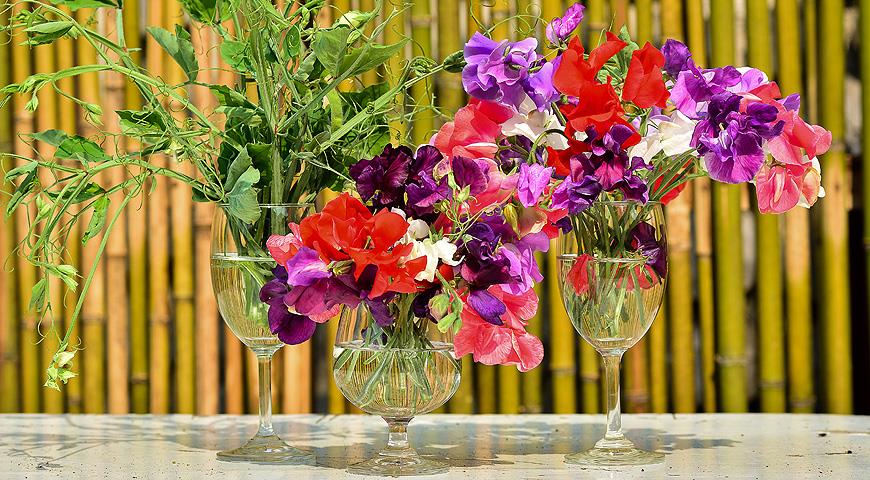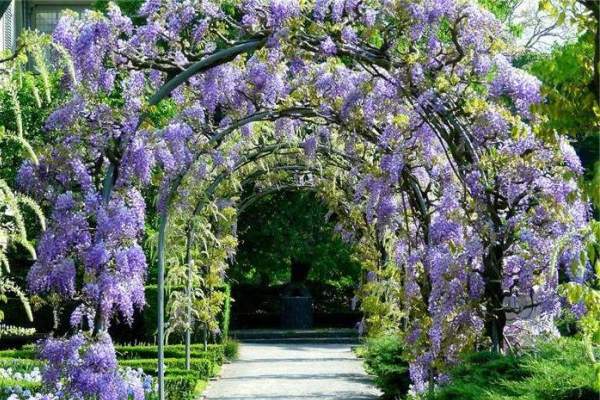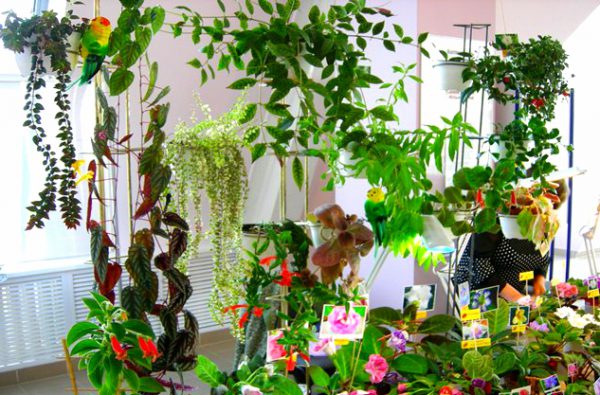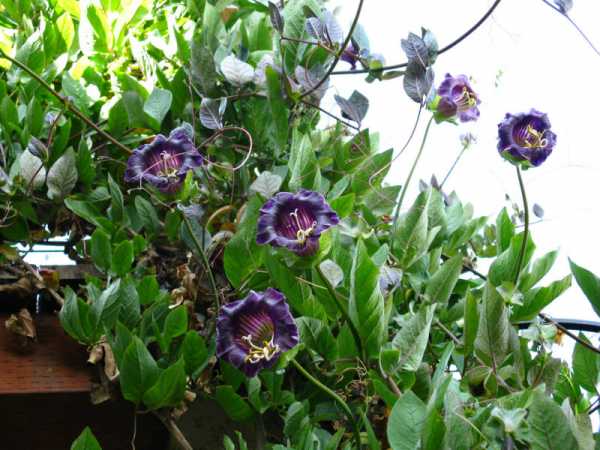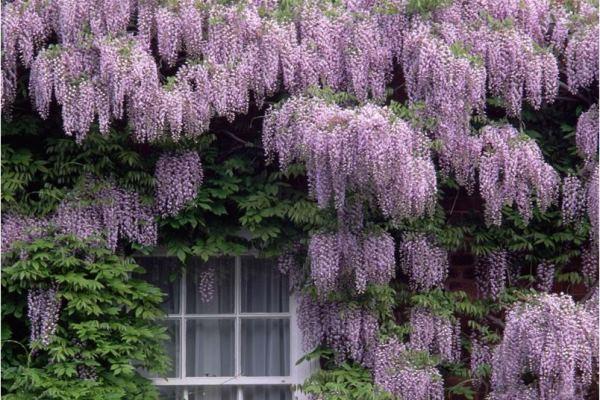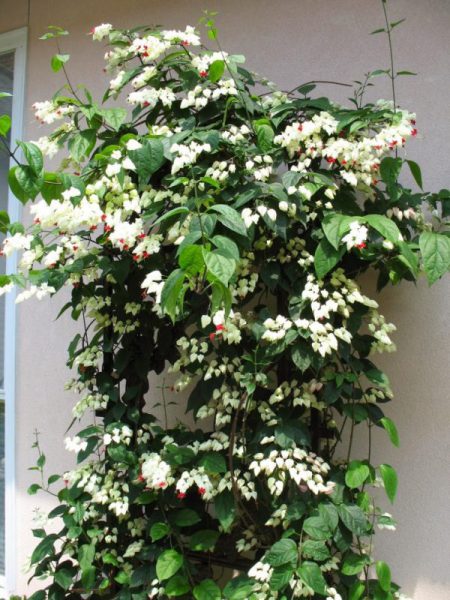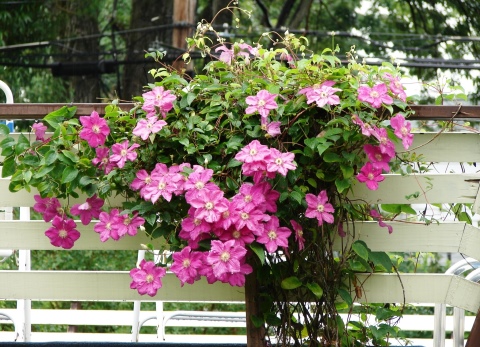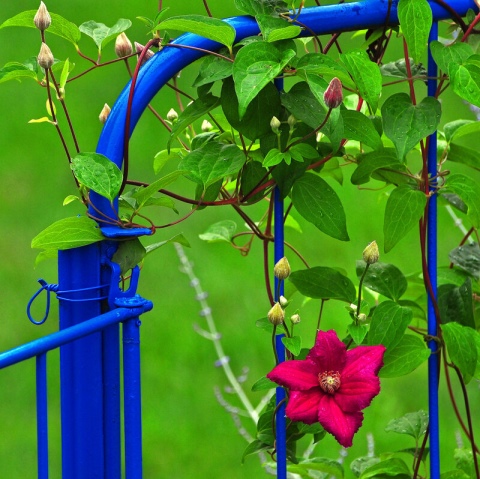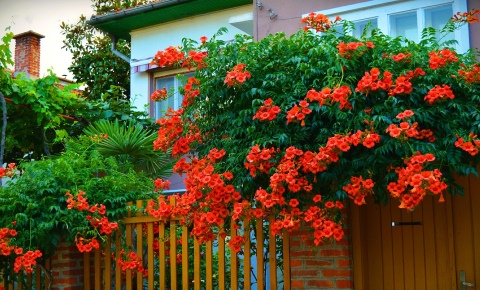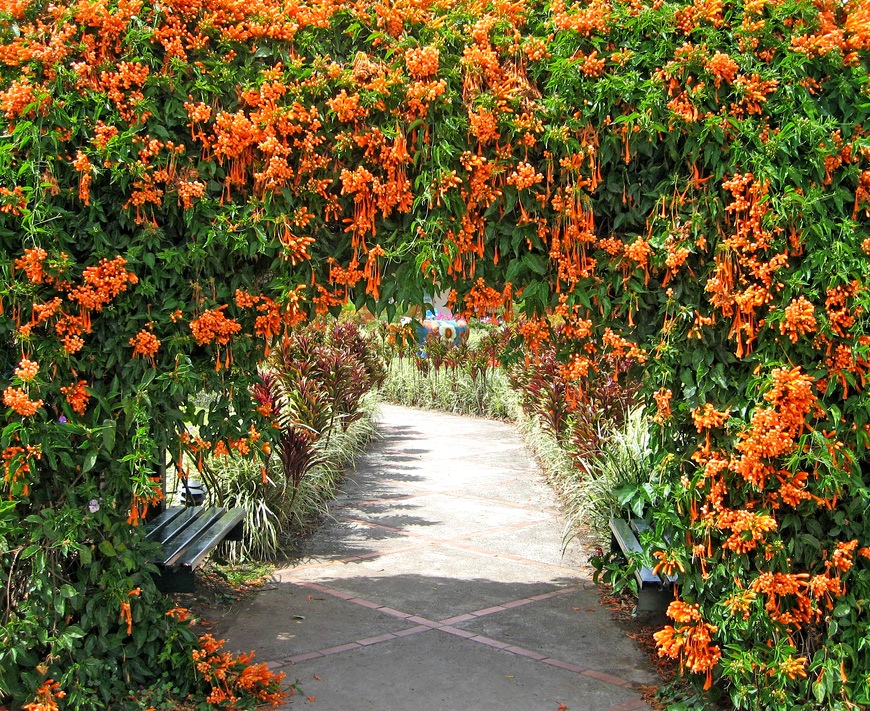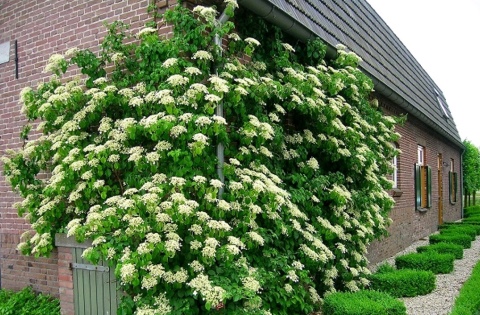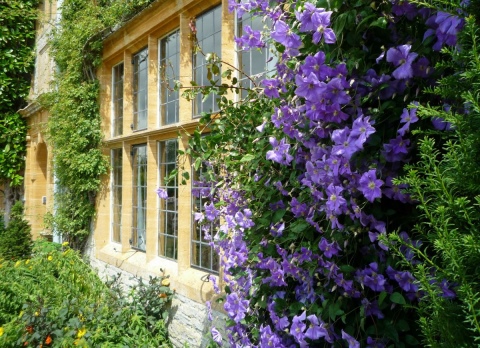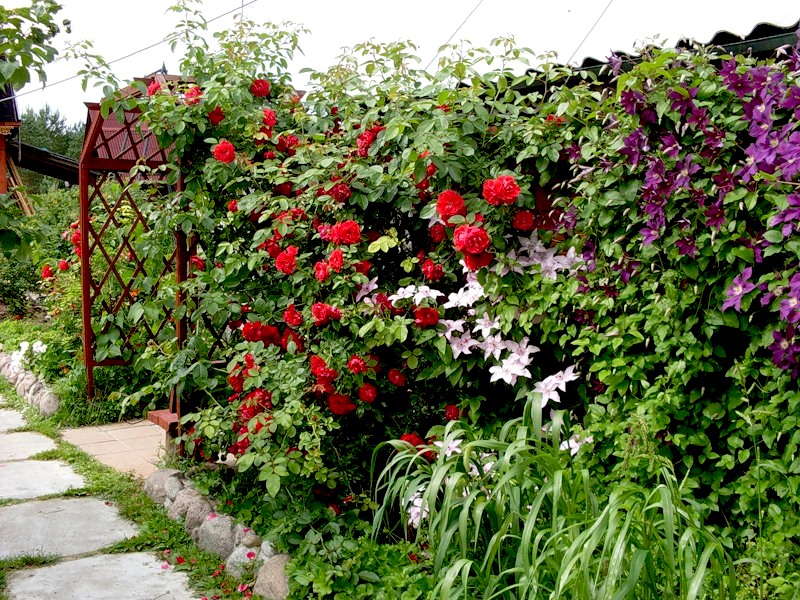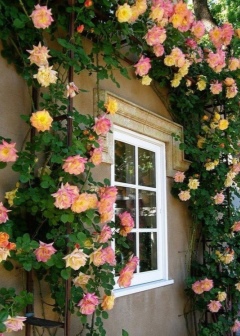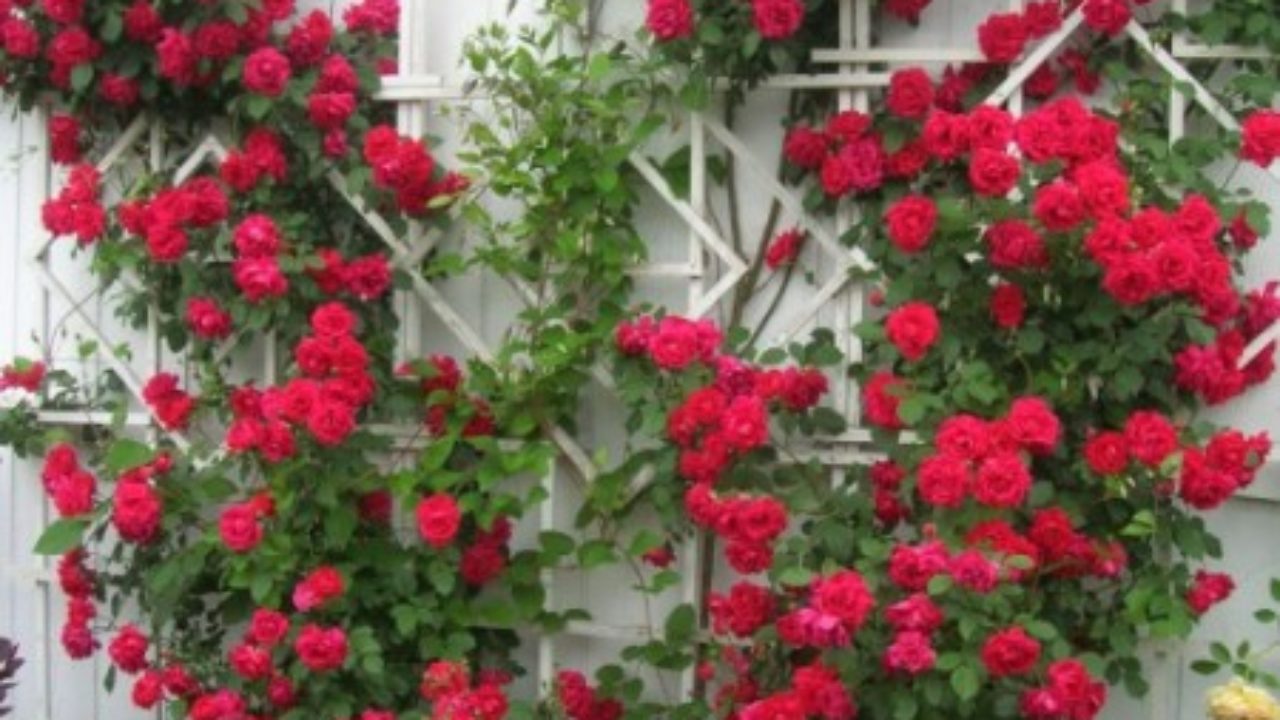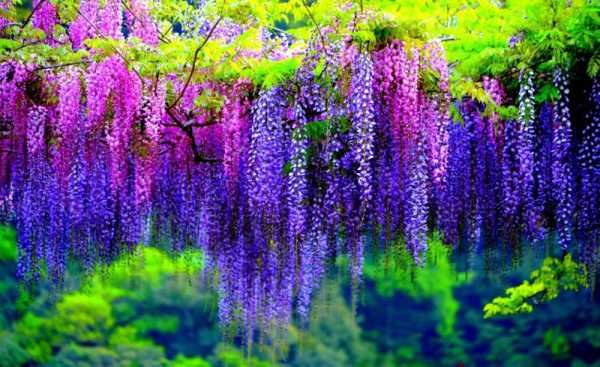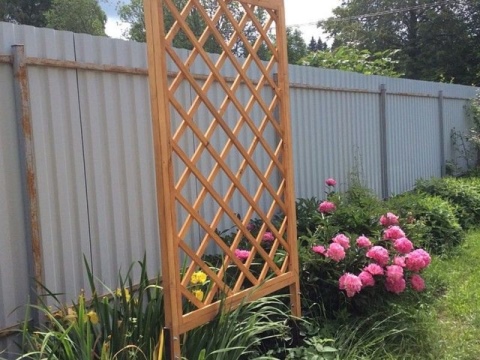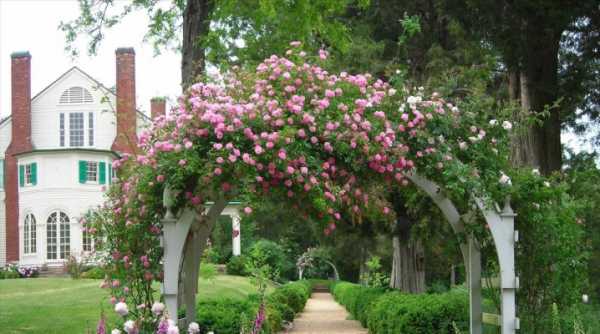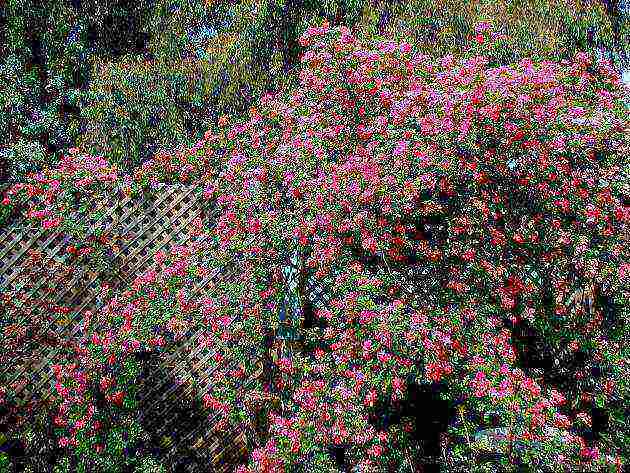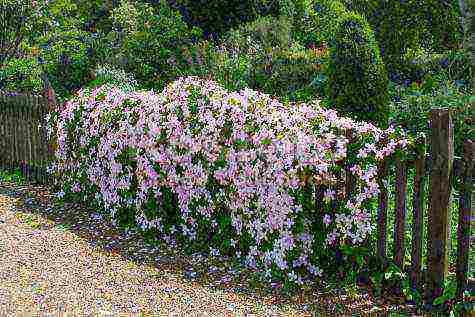Long-term joy: compositions from perennial vines
Gardeners often plant perennial curly flowers. They grow for decades if the care is right. The most demanded ones:
- clematis;
- wisteria;
- Kampsis;
- honeysuckle;
- girlish grapes;
- climbing roses
- ivy.
Clematis
Clematis is a charming vine with large flowers, powerful roots, entwining gazebos, arches, verandas. It grows all over the world, there are more than 200 of its species, a dozen of them are grown here. Simple and double clematis flowers of various shades:
- blue,
- red;
- lilac;
- white;
- purple;
- blue;
- cherry;
- beige.
Care consists in loosening the soil. We need spring feeding with urea (a tablespoon per bucket of water), closer to autumn, the liana requires complete mineral fertilization. An adult bush is watered abundantly three times a week - up to two buckets of water.
Propagated by cuttings, dividing the bush, layering. The easiest way is to cut the cuttings with knots from the middle of the shoot. They do this in early summer. The cuttings are planted in the ground, covered with a jar on top in the shade until the roots appear.
Clematis is transplanted to a sunny, windless place. Liana does not like acidic, moist soil; drainage is needed. The transplant takes place in spring or autumn. V soil is added compost, mineral fertilizers. The vine grows quickly. Before winter, the soil is loosened, the shoots are cut off, a knotty stump remains, it is covered with soil by 10 cm. The plant is frost-resistant, cold -35 is not terrible, it also tolerates heat well.
The flower suffers from infectious diseases, begins to fade. Withered shoots are destroyed, the plant and the soil are treated with a copper-soap emulsion. Prevention of fungal diseases is carried out by spraying the shoots with foundationol (10 liters 20 g).
Many pests are dangerous for clematis - spider mites, aphids, bears, mice, caterpillars, snails. The roots are damaged by small worms - a nematode, the plant dies. The method of dealing with a nematode is planting a number of calendula, parsley, marigolds, dill.
Wisteria
Wisteria is a luxurious southern perennial native to eastern countries. Interesting by hanging half-meter brushes of blue, pink, lilac color.
Campsis
Campsis is a magnificent perennial that decorates fences, trellises, arches. Its bright flowers - orange, yellow, red - delight the eye.
Honeysuckle
Honeysuckle is a liana-like plant with inedible fruits that looks great in garden plots, thanks to its decorative features - abundant flowering, dense foliage, and a wonderful aroma.
Maiden grapes
Girlish grapes decorate walls, fences, verandas. Easily propagated by cuttings, layering. It is adored by gardeners, it is unpretentious, it grows rapidly, winding around large areas.
Climbing roses
Climbing roses clearly claim to be a king among the entwining garden favorites. Their beauty, aroma emanating from arches entwined with them, gazebos fascinate. A variety of shapes, colors allows you to make wonderful compositions.
Ivy evergreen
Ivy is evergreen, intertwining the surface grows wherever it is planted. Care consists in watering, the soil must be moist. Forms luxurious thickets, can easily completely entwine the building.
Moonseed
Only two varieties of this climbing plant are known: the Daurian moonseed (or in the people - Daurian ivy) and the Canadian moonseed. Both species are suitable for cultivation in the middle lane, although ovaries may fall off on the Daurian moonseed forest after frost.
This liana blooms with small white paniculate flowers in mid-summer.Moonseed fruits look juicy and appetizing, but, unfortunately, they cannot be eaten - they are toxic. If small children are often at your summer cottage, it makes sense to plant only male plants in order to prevent pollination and the formation of ovaries.
In general, the moonseed is unpretentious in care, decorative, this plant looks especially impressive when the vine is intertwined with trees and shrubs. During the season, the Daurian moonseed plant changes the color of its foliage from red to lemon, the Canadian - from rich green to bright yellow.
| Vine length (m) | Flowering time | Soil type | Peculiarities |
|
0,7-5 |
Mid June - mid July | Wet sandy loam and light loamy fertile |
The fruits are poisonous |
Creeping vines to create a green carpet
Creeping vines are ideal for decorating a fence. With the help of small sucker-roots, they are able to conquer any height, freely covering a solid fence of 3-4 meters. The most picky among the creeping vines: petiolate hydrangea, honeysuckle and kampsis. Having planted them in spring or autumn along a fence or support, the very next season you can observe how powerful stems of vines confidently climb a vertical surface, covering the fence with a green carpet.
Petiolate hydrangea is a beautiful liana-shaped shrub that freely reaches a height of 8 to 20 meters.

Against the background of green ovoid leaves, pinkish-white flowers collected in paniculate inflorescences look spectacular
Among the most attractive varieties are: "Miranda", the leaves of which are decorated with a yellow-cream border, as well as oak-leaved hydrangea with lush cone-shaped inflorescences and dense foliage, which turn into rich purple hues in autumn.
Wisteria is perfect for decorating sturdy concrete, stone and brick fences. A light-loving liana, decorated with white, lilac or pink clusters of miniature flowers, can transform even the most ordinary-looking fence into a spectacular fence of the site.
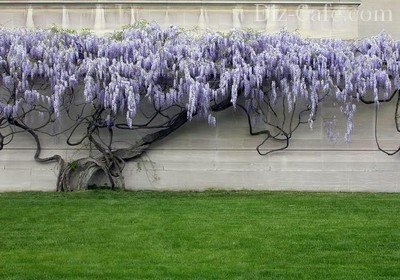
Wondrous flowers collected in racemose inflorescences, blooming in early May, completely obscure the foliage and cover the fence
In landscape design, the most common are:
- Chinese wisteria - reaches a height of 20 meters. In the summer months, it is decorated with loose clusters with pale purple flowers exuding a fruity aroma;
- profusely flowering wisteria - differs in the larger size of ovoid leaves and the splendor of lowered white inflorescences. The branches of the plant are originally twisted clockwise;
- Japanese wisteria is one of the most spectacular lianas, the branches of which reach a height of 8-10 meters, twisting clockwise around the support. Dense inflorescences with flowers of lilac-blue and white shades reach a length of 50 cm.
The heat-loving liana kampsis is known to many gardeners for its unusual orange flowers, which outwardly resemble small gramophone. Blooming in the second half of June, the liana pleases with an elegant flowering until the beginning of autumn. She is not afraid of any adversity: the liana calmly tolerates frosts down to -20 ° C.

The main advantage of this perennial vine is gas and smoke resistance, as well as excellent resistance to urban conditions.
When growing a plant, one should take into account its ability to grow rapidly, reclaiming territory from weaker "neighbors". Timely pruning and fertilization will keep the plant compact and decorative throughout the season.
The unpretentious honeysuckle plant can not only decorate the fence, but also bring a special aura, create a mood. Honeysuckle is rightfully considered the champion of unpretentiousness. The curly beauty prefers sunny areas, but also tolerates partial shade. It is not demanding on the composition of the soil, but gladly responds with fast growth and abundant flowering to fertilizing with organic fertilizer.

Emitting a subtle sweetish aroma during flowering, honeysuckle is able to make a suburban area a semblance of paradise
Honeysuckle is unusually beautiful during the flowering period, which falls on the first month of summer. Collected in inflorescences, graceful flowers can have the most incredible shades, starting with pale white and yellowish and ending with a spectacular combination of pink and orange. The most attractive varieties are: ´Serotina´ with bright red and crimson flowers, Korolkov's honeysuckle with pale pink inflorescences, ´Grahm Thomas´ with cream and golden yellow flowers.
Care features
Curly flowers are unpretentious to care for, but there are several mandatory actions, regardless of the type and variety of plants. They will help keep your garden crops safe and sound.
- Before planting, you need to properly prepare the support.
- A staggered arrangement of various plants is preferred.
- Pruning is necessary on time (depending on the variety), as well as watering and fertilizing.
- Like all plants, climbing flowers need weeding and treatment from pests. Otherwise, the weeds will take up all the moisture and nutrients, which in turn will greatly slow down the growth of the flower.
- As necessary, you need to tie up adult stems to supports and cut out the dried ones.
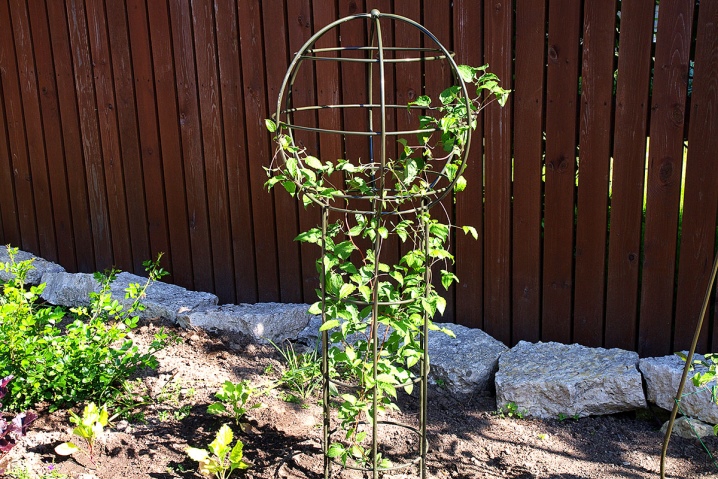
At the end of each season, the soil under the flowers must be mulched. Deadwood is best suited for perennial crops. In the case when pruning of plants will occur in the spring, you can use sawdust or straw for mulching. This will help the flowers to winter well.
It is important to know that such cultures do not like transplants very much, therefore, it is necessary to determine the place and supports in advance.
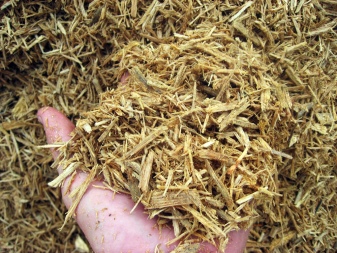

In order for the described crops to develop quickly and correctly, it is necessary to select plants suitable for the region in which they are planned to be planted. The following weather phenomena are of great importance for plants:
- the amount of precipitation in the region;
- Rose of Wind;
- temperature regime;
- soil characteristics.


Classification of perennial varieties
Climbing vines are grouped into two categories: woody and herbaceous. The first of them continue to grow every spring from where they left off last year, increasing in length, multiplying foliage and flowers. The trunk becomes harder over time, resembling a tree. The second, if they themselves do not disappear, needs pruning to ground level. This root will sprout in spring.
Tree crops are frost-resistant and unstable to winter cold. Withstanding winter frosts well, they do not need to be removed from supports for the winter period and do not need shelter.
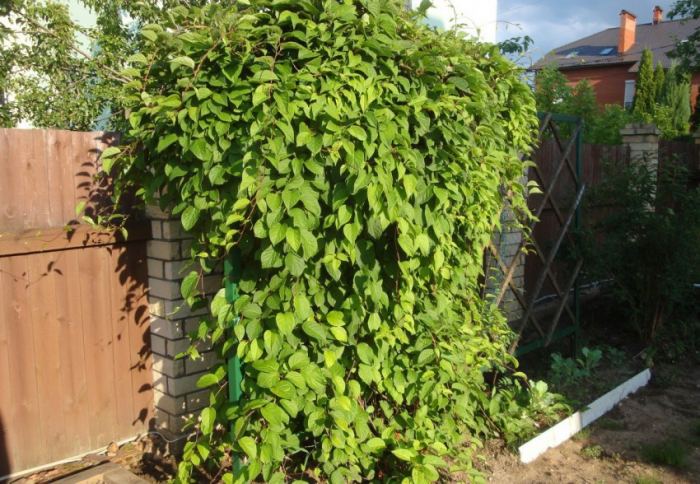
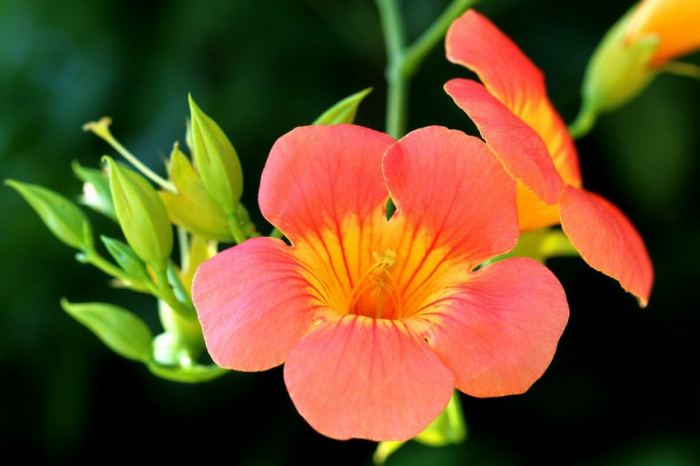
Types of perennial vines:
- climbing rose, causing admiration and delight of lovers;
- Kampsis, which is called the "sleeping beauty", with amazing gramophone flowers;
- beautiful vines are not a compliment, but the name of a variety of a perennial climbing plant;
- actinidia with foliage reddening towards autumn and winter orange berries;
- girlish grapes, wonderfully greening walls and hedges, changing the color of foliage to burgundy by the end of the season;
- honeysuckle with an attractive aroma for butterflies and edible fruits;
- ivy - the most common garden vine, creating a solid carpet of foliage;
- clematis with flowers of various colors, competing with the rose in beauty;
- wisteria, distinguished by the density of flowers, because of which leaves are not even visible;
- bougainvillea with delightful flowers and creeping shoots.
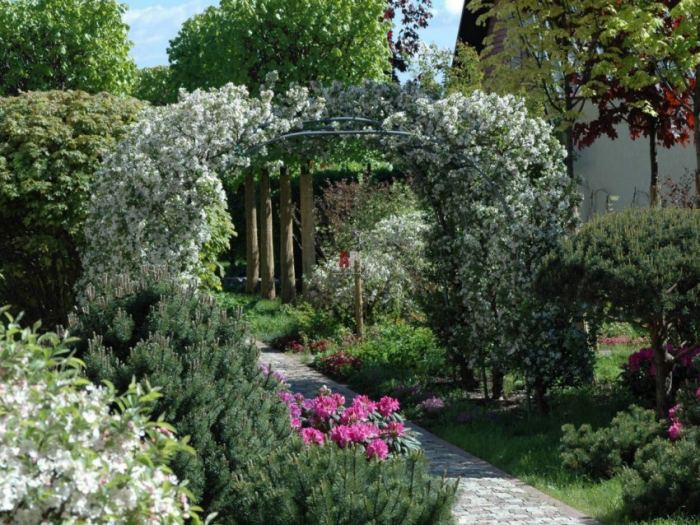
Among the perennial climbing plants, there are ordinary vines, found everywhere, artless and unassuming, not claiming great care efforts. More experienced gardeners take on the planting of exotic plants that are adapted to our weather and worthy of attention.
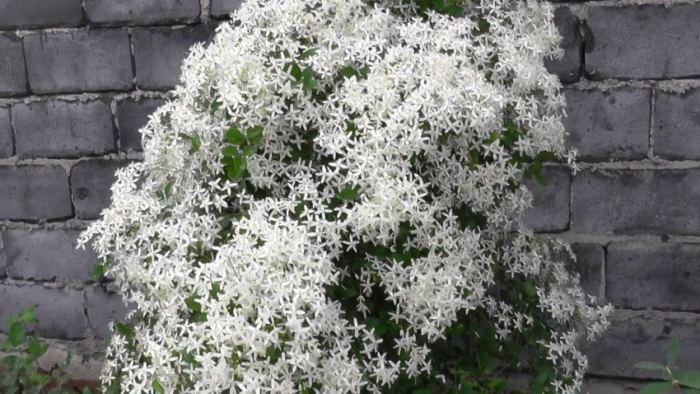
There are a huge number of wonderful weaving garden vines that allow you to transform the site and hide all its defects, create corners of comfort and joy in the garden.

Popular flowering perennial loaches
This name comes from the Latin convolvere - "to roll up". A grass or shrub envelops the plant or support with its stem, sometimes drowning it out. An example of this is the field bindweed, better known as "birch". Includes 75 actual and 836 suspected species.
Bougainvillea
One of the representatives of loaches, whose homeland is South America. An evergreen shrub or tree can grow up to 5 meters in height. Many species have thorns, but the latest cultivars developed lack this protection. Despite the nondescript flowers, it has very bright, usually purple bracts, and it is they that give beauty. Bougainvillea loves warmth and dies if the temperature drops below +5 degrees.
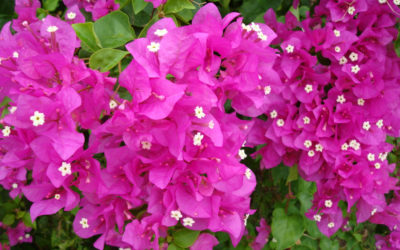
Bougainvillea flowers
Propagated by cuttings, they are selected from edged material. They are planted in a warm soil, not lower than +25 degrees, and covered with glassware. Bougainvillea loves water for watering and spraying, but don't overdo it. For the winter, plants are brought into a heated room. At home, it can be struck by spider mites and aphids, they can be fought with the help of insecticides.
Honeysuckle
Another genus of shrubs is honeysuckle. They can be curly or creeping, or they can be erect. There are 103 species in total, and many of them are used in gardens as ornamental shrubs. Shrubs get along well in groups and are able to braid gazebos and alleys. In some species, the upper or all leaves grow together, forming a single whole, in the center of such a plate a shoot passes.
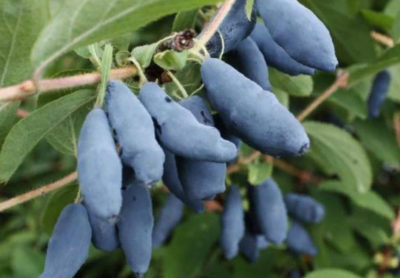
Siberian honeysuckle
The flowers are quite large, light warm shades, sometimes bluish, appear at the end of May and delight with their beauty until mid-June. After flowering, red fruits appear in the form of berries.
In Russia, the northernmost species growing in nature is Blue Honeysuckle. Her flowers are yellowish, and the berries are blue. Honeysuckle differs in that its leaves do not grow together.

